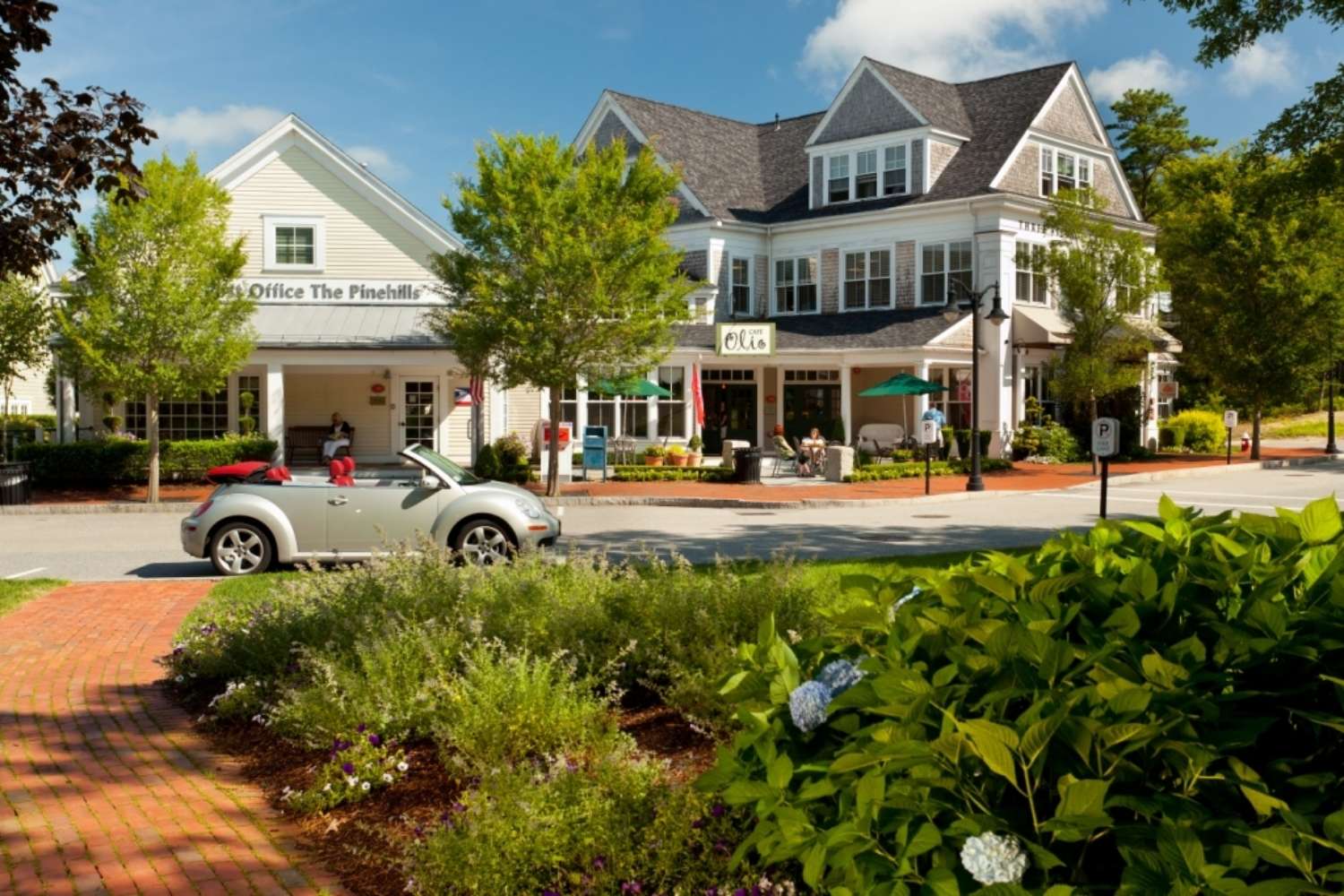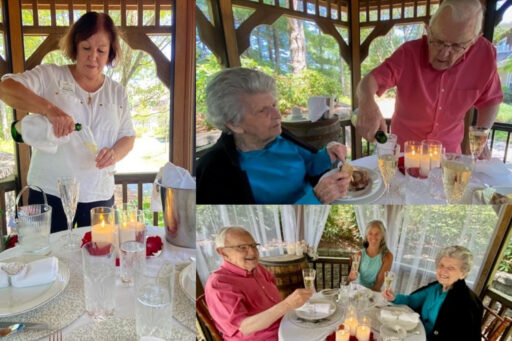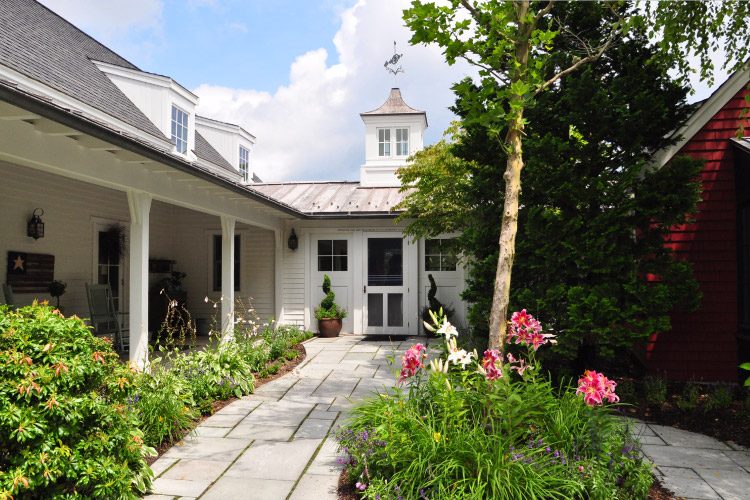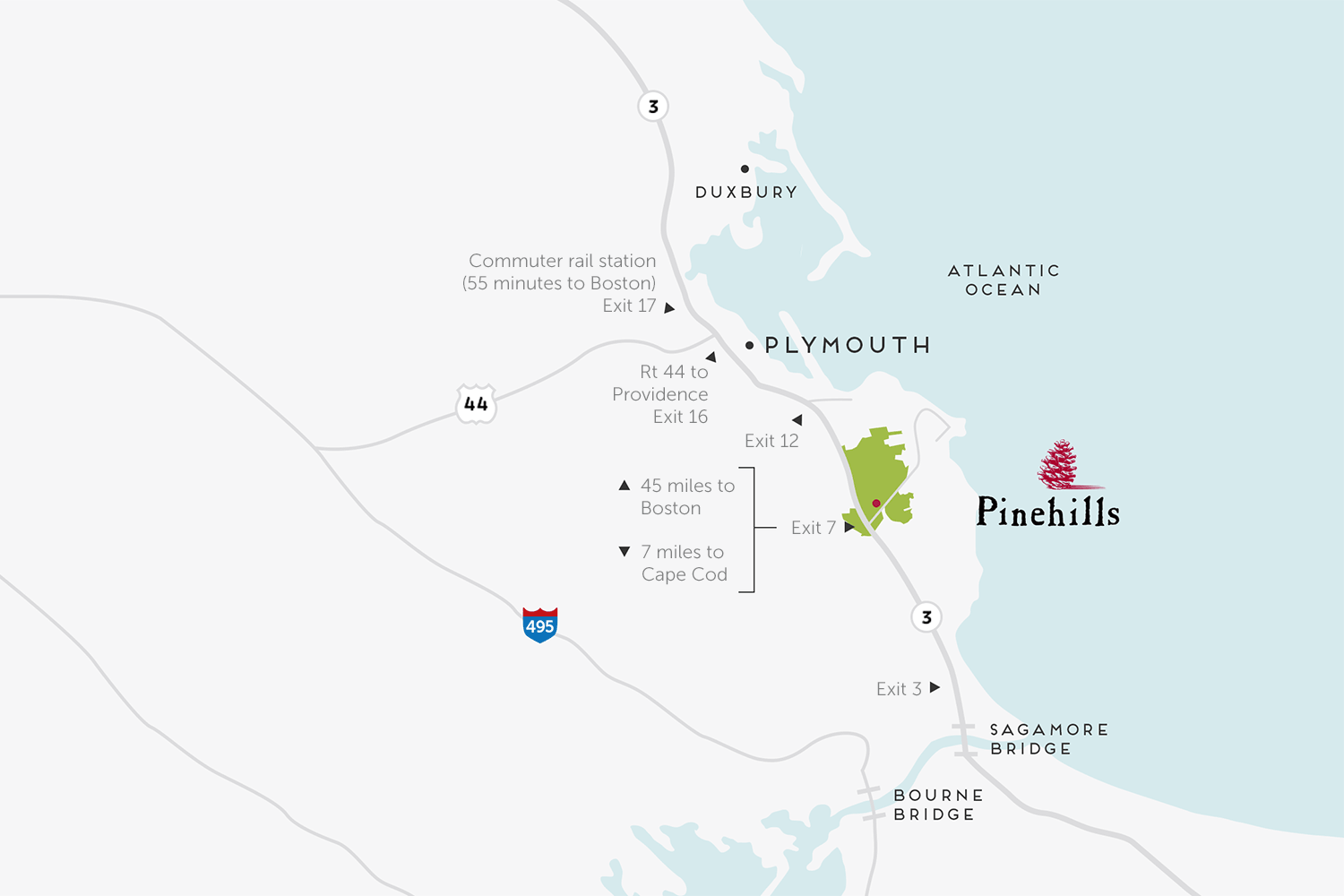Land Development Magazine Fall 2011. By: Tony Green.

Mixed use communities in rural settings are the exception, not the rule. Yet, what used to be 3,200 acres of hilly, forested land in Plymouth, Massachusetts has become The Pinehills: today, home to more than 1,500 families and a 150,000 sq ft town center. Those families buy their groceries at The Market in the Village Green, dine at a number of restaurants and cafes, mail their letters at the new post office, visit the bank or one of four doctor’s offices or seek services from local businesses that range from insurance and accounting to legal and financial planning. This new place has become so accepted as part of the greater community that Plymouth has added The Pinehills as the town’s sixth village center; quite a distinction since the town of Plymouth has had only five village centers for decades.
An Award Winning Community
In 2011, The Pinehills won more categories of NAHB’s Best in American Living Awards than any other community, including home of the year, best single family home, best green home and best neighborhood. In the past, the community has also won national awards from Builder magazine and from NAHB for best smart growth community, best mixed use community, best site plan, a local environmental business award for innovation and was home to HGTV’s 2010 Green Home.
Clearly The Pinehills, which is larger than many New England towns and is situated 45 miles from Boston and seven miles from the nation’s oldest settlement at Plymouth Rock, has found a formula for success—and that success has continued even during the recent economic challenges.
The reasons for that success derive from two important issues: making place and a permitting process that changed zoning to enable that place to occur.
1) The community is distinctive; the sense of place palpable. The award-winning plan for the community stipulates that it be built on only 30 percent of available land, leaving over 2100 acres of space open for recreation and views. This smart growth community supports sustainability and entertainment in how the land works, as both potential home buyers and residents attend the many events from summer movies, weekly concerts and the annual art show to the annual Holiday “reindog” parade featuring dogs of all sizes and shapes decked out in their holiday finest!
2) A local permitting process that worked. The local permitting process allowed both increased density and open space, while also building flexibility into the planning, enabling creative response to economic change. Town support for the neighborhood has remained strong. At the same time, tax revenue from The Pinehills has already exceeded estimates for full build-out.
The Pinehills has become a prototype and changed development in Plymouth.
The Distinctive Place that is Pinehills When the first words of praise expressed by resident’s center on the place they live, instead of the features of their new homes, something unique has occurred. People choose to live, work and play in this community because of how it affects the quality of their lives. Residents can go out the back door and hike for miles or go out the front door on the way to golf. They can walk to the Village Green for a cup of coffee, to shop, or to attend one of many planned events. They have 10 miles of trails to choose from, with choices ranging from pine-needle-covered paths to paved and lighted paths that connect the neighborhoods to the Village Green. The Village Green is the heart of The Pinehills. Being the only commercial district within a 12-mile stretch of interstate highway, The Village Green at The Pinehills attracts thousands of people each week. Its significance to residents of the South Plymouth region and The Pinehills is why the Town of Plymouth added The Pinehills to its five other village centers.
The anchor of the green is a traditional New England common: a nearly two-acre park with a sloping lawn under pine and oak trees that looks as if it has been here for centuries. With its fully mature trees, the Village Green is also the main area where events are held, which range from large-scale music concerts and festivals to outdoor movies, holiday events and a food truck festival of mobile kitchens that attracted more than 4,000 people from all over New England this June. These events serve as a differentiator for the Pinehills, an added value for residents, and a magnet for attracting the outside public.
Around The Green is The Market—a 14,000-square-foot, full-service grocery store— as well as a U.S. Post Office, fire station, café, wine and spirits shop, spa, hair salon, specialty gift store, a racquet and fitness club, financial planner, insurance agency, four medical practitioner offices and a bank. Soon these businesses will be joined by a family run gas station. The Green and The Market create the special sense of place. As one resident put it: “I moved to The Pinehills in May and hadn’t yet felt like it was my home. But (in September) when I walked over to the Green (for a Concert) ... I had no idea my notion of where I hang my hat would change. The place, this Pinehills, it’s a pretty cool spot.”
But the common areas and green respites are also a sales strategy for the Pinehills: a way to attract potential buyers into the area: 70 percent of the over 1,000 shoppers at The Market each day come from outside The Pinehills.
Another center of activity and social connection for residents of The Pinehills is the Stonebridge Club, a 7,500-square-foot clubhouse available to all residents of The Pinehills. At the Stonebridge Club, residents take classes, play or listen to music, attend theater events, participate in club meetings and in children’s activities and engage in volunteer opportunities. The clubhouse itself is a New England-vernacular building reminiscent of a large barn, and residents run the programming which ranges from an opera club to a civil war history group to a hiking club and a children’s club.
Good Research Leads to Good Planning
From the first day developers stepped onto this land, they could see how homes and nature could coexist in this special place. The pines and hills meant that roads and homes could nestle into the landscape without disturbing nature much. At the same time, the new community needed to reflect the 50-year shift national statistics reveal has occurred—from a country with 50 percent of homes going to families with children to a situation in which 80 percent of homes are now bought by families without children. This left a large untapped market in a state with some of the oldest housing stock in the country. But this shift needed to be backed up by specific research.
The original market research that led to the creation of The Pinehills began with workshops in small groups over breakfast. Prospects who had inquired about the community while the permitting was ongoing were asked to describe their ideal home and neighborhood by creating collages using pictures from magazines. Just as important as the collages were individual presentations of collages to the group as people explained their desires. The dreams that arose from these exercises seemed to grow out of the 3,200 acres of hilly forested land. For one thing, the theme of a scenic view was inherent in their choice of pictures, which focused on the outside. The breadth of their home descriptions led the developers to invite multiple builders to offer a wide range of home choices. As a result, nine builders with distinct niches offer homes that range from rental apartments, condominium townhomes and cottages to age-qualified, single family and custom-built homes. Prices range from the high $300,000’s to nearly $2 million.
Permitting Community
The master plan concept of mixed use in a rural environment had never been tried before in America’s first town of Plymouth, founded in 1620. Town and state authorities held months of public workshops and more than 200 public meetings with Plymouth residents, preparing for the New England Town Meeting, where zoning changes would require a super-majority of two thirds and where any resident could speak.
In July 2000 Town meeting voted to embark on an extraordinary partnership between Town of Plymouth, other officials and those who would see the project move forward. The Pinehills Master Plan with amendments to the open space mixed-use zoning and subdivision rules and regulations was approved in a process that was a credit to the Town of Plymouth and to Plymouth Town Meeting. The result was a plan with innovative zoning, environmental protection, historical integrity and a sense of place for this very old and still rural landscape.
For example, density went from one home per three acres in the original zoning proposal to an average of three homes per acre and 1.3 million square feet of commercial space concentrated on less than 1,000 acres (30 percent of the land.) In other words, density increased nine times while open space increased from zero to over 2,100 acres. Road layouts changed from the standard 60 feet to as little as 18 feet and design speeds decreased from 40 to 20 miles per hour allowing the natural twists and turns of the land and the narrow widths to naturally slow down the traffic. These changes allowed the roads to follow the contours of the land. Lot requirements changed from 200-foot frontages and three-acre minimums to 19-foot frontages with no minimum size. The developer and builder teams literally walk the land to site homes and neighborhoods. As a result, each home is placed for view and to maintain rich forestry. The planning process, moved from the rigid geometry of minimum frontage and lot size to the art of finding the right place for each particular house.
The innovation and creativity demonstrated on the local level also provided momentum for state regulators to consider innovative permitting approaches with respect to environmental impact review and wastewater management. In return, The Pinehills has provided the state with input for making future policy changes that encourage smart growth and low impact development, and the community is now a case study on the state’s website.
Favorable Results
This cooperative approach has led to ten years of successful home sales to a wide range of buyers including first-time home buyers, young families, working baby boomers and retirees—a mix that reflects the diversity of a town. This past year, two-thirds of all new home permits in Plymouth were at The Pinehills.
For the Town of Plymouth, the growth of The Pinehills has created more than $730 million in new tax base with annual gross tax revenues of $10 million (net revenues of $9 million) as of January 2010. A financial consultant to Plymouth has called The Pinehills “the single most fiscally favorable mixed-use development from a cost-to-revenue ratio and in terms of actual net dollars returned to the community on an annual basis” in the consulting company’s history of such fiscal studies. While not yet half built, net tax revenues have already exceeded what was estimated at Town Meeting ($6.4 million).
Pinehills as Prototype
Because of its success, The Pinehills is often viewed as a prototype for creating “home and community,” not just building houses. The new and innovative zoning and land planning principles have had a direct impact on land use patterns within the Town of Plymouth in general, fundamentally changing the way the Planning Board and other builders approach land use with an emphasis on smaller lots in combination with open space and other uses.
The Pinehills as prototype reaches well beyond the local area, also. Stockholm-based Skanska, one of the world’s largest construction companies, sent an executive on a mission to tour the world for six months benchmarking the very best examples of community. The Pinehills was the top example, and Skanska officials noted that The Pinehills added community to the best of what Skanska does, which is to focus intently on environmentally sustainable design and commitment to nature being a part of everyday life.
In addition, each year MIT, Harvard University and Tufts University plan annual educational site tours for graduate students to The Pinehills as living laboratory studies for next-generation building.
Recession and The Pinehills Strategy
The first signs of today’s difficult economy came when sales for 2006 came in lower than 2005 at The Pinehills. However, the community’s planners adapted by convincing each builder to halt building unsold speculative inventory and to begin planning how to differentiate through redesigning home choices and specifications in response to changes wrought by the economic challenges. Controlling the level of inventory alleviated the pressure that unsold homes would create on price. Today, seven of the nine builders offer new home styles specifically oriented to the more down-to-earth preferences of today’s market and to differentiate themselves from resales of already built homes.
Since the fall of 2010 after three years at a consistent pace, sales at The Pinehills accelerated. Even with the challenging economic climate, 125 new families moved to The Pinehills in 2010, the same number as in 2009. Meanwhile, 2011 sales are 20 percent ahead of last year, with 76 sales made by mid-year. In addition, another 50 families have moved into the second phase of Avalon Bay apartments, which opened late spring, bringing the current total at The Pinehills to more than 1,500 families.
This spring also saw the opening of the Rye Tavern, a renovated 1792 tavern, which looks out at the oldest unpaved road in continual use in the United States. The Market, which opened in the depth of the recession, is now growing at double-digit pace in terms of annual sales and customer transactions.
The Pinehills reputation, whether from the immediacy of experience or from visiting the shop where they “know your name,” has continued to grow. In many ways, the open space experience links the residents while density brings them together, whether that interaction happens when getting their mail at the post office, eating at the café, walking on a trail, or shopping in The Market. The Pinehills practice of caring about both the built and natural environment and the people who live and work in the community has become a brand.
Tony Green is managing partner for Pinehills LLC. You can reach him at 508.209.9000 or tgreen@pinehills.com.





